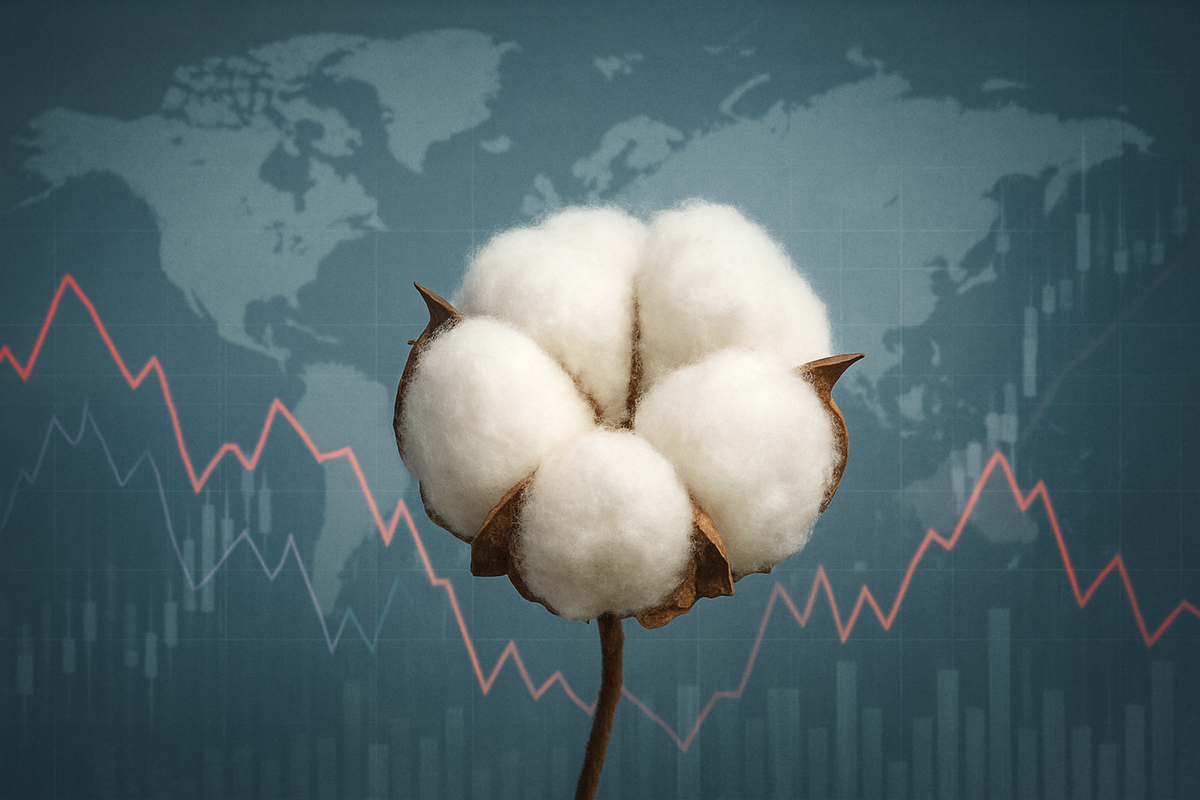
The global cotton market is experiencing a period of significant volatility and mixed activity as of October 24, 2025, with prices caught in a tug-of-war between supportive external factors and persistent underlying bearish pressures. At midday, ICE December cotton futures showed a modest uptick, settling higher, yet the broader trend indicates a market grappling with uncertainty. This immediate push-and-pull dynamic has significant implications for the entire textile supply chain, from agricultural producers to major apparel retailers, as stakeholders attempt to decipher the true direction of prices in an opaque information environment.
This current state of flux underscores a complex financial landscape where macroeconomic forces, supply-demand imbalances, and geopolitical developments are converging to create a highly sensitive market. The immediate implication is heightened risk and opportunity for traders and businesses reliant on cotton, demanding agile strategies to mitigate potential losses or capitalize on emerging trends. The absence of critical market data further exacerbates this challenge, making informed decision-making more arduous in an already intricate global commodity market.
A Confluence of Factors Drives Midday Volatility in Cotton Futures
The recent movements in cotton prices reflect a delicate balance of influential factors. On October 24, 2025, ICE December cotton futures settled at 64.07 cents per pound, marking a 0.33-cent increase, building on earlier gains seen throughout the week. This recovery comes after a period earlier in October where benchmarks, including the NY/ICE December contract, had dipped below the 65 cents per pound threshold. However, this upward momentum is fragile, as prices also saw a slight dip to 63.92 USd/Lbs on the same day, illustrating the market's inherent instability. Despite a 0.24% rise over the last month, current prices remain 9.56% lower than a year ago, signaling a sustained bearish undertone.
Several key elements are contributing to this mixed activity. A significant booster has been the surge in crude oil prices, driven by restrictions on Russian crude imports and reduced purchases by Chinese buyers. Higher crude oil prices invariably increase the cost of synthetic fibers like polyester, thereby enhancing cotton's competitive edge and stimulating demand. Concurrently, easing US-China trade tensions have offered some support, though ongoing frictions, such as China's reported shift towards Brazilian and Argentinian cotton over U.S. supplies, continue to cast a shadow over American cotton exports. Furthermore, new geopolitical developments, including the termination of trade talks with Canada, introduce additional layers of uncertainty into global trade dynamics.
A critical factor exacerbating market uncertainty is the ongoing U.S. government shutdown, which has delayed the release of vital economic and agricultural reports, most notably the USDA's monthly World Agricultural Supply and Demand Estimates (WASDE) report. This information vacuum forces market participants to operate with incomplete data, fostering speculative trading and contributing significantly to the observed mixed activity. Compounding these issues are persistent global demand concerns; despite a modest rebound in consumer spending in Q2 2025, the overall outlook for 2025 anticipates sluggish global economic growth, which is expected to continue dampening demand for textiles and apparel.
On the supply front, global cotton production for the 2025/26 season is projected to increase, potentially outpacing mill use, with notable increases expected from China, India, and Australia. Conversely, U.S. cotton acreage and production are anticipated to remain low due to weaker price expectations compared to competing crops and high input costs. India, a major player, faces reduced output but rising demand, prompting an expected surge in imports. Recent cuts in India's import duty on cotton (until September 30, 2025) have lowered domestic costs, yet concerns about crop quality due to heavy monsoon rains persist. The Cotton Corporation of India (CCI) is also preparing for significant domestic purchases, which could further influence global supply dynamics.
Corporate Fortunes Tied to Cotton's Volatile Weave
The turbulent currents within the cotton market are creating a landscape of both opportunity and peril for public companies across the textile, apparel, and agricultural sectors. As raw material costs fluctuate and demand patterns shift, the profitability and strategic direction of these entities are directly impacted.
Textile manufacturing companies, which convert raw cotton into yarns and fabrics, are at the forefront of this volatility. Firms heavily reliant on pure cotton products, such as Vardhman Textiles (NSE: VTL), Welspun India (NSE: WELSPUNIND), and Texhong Textile Group (HKEX: 2678), face significant pressure. Any upward movement in cotton prices translates directly into increased raw material procurement costs, squeezing their profit margins unless these costs can be effectively passed on to apparel brands or consumers. Companies with less agile supply chains or those holding substantial cotton inventories could see their profitability eroded or face inventory holding costs. Conversely, diversified manufacturers, or those focusing on synthetic fibers like Unifi, Inc. (NYSE: UFI), a producer of multi-filament polyester, may find themselves in a more favorable position as textile companies seek alternatives to mitigate cotton price risk. Indian textile manufacturers, in particular, may benefit from the government's import duty exemption on cotton.
In the apparel sector, the impact is equally pronounced. Companies like Hanesbrands, Inc. (NYSE: HBI), which produce a wide range of basic cotton garments, could experience significant profit reductions if cotton costs rise and they are unable to adjust retail prices without deterring price-sensitive consumers, especially amidst a global economic slowdown. Those with less diversified sourcing strategies are also vulnerable to supply chain disruptions. On the other hand, major brands with strong pricing power and brand loyalty, such as Levi Strauss & Co. (NYSE: LEVI), Nike (NYSE: NKE), and Fast Retailing Co. Ltd. (TYO: 9983), the parent company of Uniqlo, are better equipped to absorb or pass on increased costs. These companies often have diversified material sourcing, incorporating blends or other fibers, and are increasingly committed to sustainable cotton, which can offer more stable supply and cater to growing consumer demand for eco-friendly products.
The agricultural sector, while less populated by publicly traded pure-play cotton farming companies, sees its fortunes tied to these market dynamics. The overall outlook for 2025 suggests challenges for cotton producers due to persistently low cotton prices and high input costs. Farmers in regions facing reduced demand from major importers like China, or those heavily exposed to adverse weather, will struggle. However, diversified agri-businesses such as Olam Group (SGX: OLAM), which is involved in growing cotton in Australia and across various commodities, are more resilient. Their scale in sourcing, processing, and trading allows them to better manage price volatility. Furthermore, producers in countries with strong government support, like India's Minimum Support Price (MSP), may benefit from stabilized domestic prices, even as global market prices fluctuate.
Cotton's Global Threads: Broader Trends and Historical Echoes
The current state of the cotton market is more than a mere snapshot of commodity prices; it reflects profound shifts in global trade, environmental priorities, and consumer behavior, echoing historical patterns while forging new paths. The challenges and adaptations seen today fit squarely into broader industry trends, with ripple effects extending across continents and impacting diverse stakeholders.
A defining trend is the intensifying competition from synthetic fibers. Polyester and other man-made fibers continue to outpace cotton in production volume and affordability, a long-term trajectory evident since the 1990s. Lower crude oil prices further amplify this by making synthetics more cost-effective, consistently dampening demand for natural cotton. This necessitates innovation from the cotton industry to differentiate its product, often by leveraging its natural properties and emphasizing sustainability. Simultaneously, the imperative for sustainability and ethical sourcing is growing stronger. Consumers are increasingly aware of the environmental and social impacts of their purchases, compelling brands to demand greater transparency and integrate options like organic and recycled cotton. This trend also opens the door for alternative natural fibers such as hemp and Tencel, further diversifying the textile raw material landscape.
The ripple effects of these market dynamics are far-reaching. Cotton farmers, particularly in the U.S., face difficult planting decisions as prices often fall below production costs, exacerbated by high input costs and an inadequate farm safety net. Brazil, with its expanding, cost-effective cotton production, is emerging as a significant competitor to the U.S. in Asian markets. For textile manufacturers and apparel brands, increased cotton prices earlier in 2025 have already led to higher raw material costs, pressuring margins and operational risks. Many are responding by diversifying their raw material sourcing to include more synthetics or alternative natural fibers. Conversely, synthetic fiber producers stand to benefit from cotton's subdued prices and potentially affordable oil, gaining further market share. The global trade landscape is also shifting, with Brazil surpassing the U.S. as a leading cotton exporter, and Bangladesh and Vietnam emerging as dominant importers due to their expanding textile industries.
Regulatory and policy decisions are also profoundly shaping the market. U.S. tariffs on cotton goods from countries like Brazil, India, Vietnam, Pakistan, and China are reshaping global trade flows, leading to reduced U.S. cotton exports to China and increased volatility. Governments, such as India, are implementing support mechanisms like increased Minimum Support Prices (MSP) to protect local farmers, underscoring cotton's strategic importance. Environmental regulations and the push for sustainability are leading to increased compliance demands and the need for certifications, creating investment opportunities in organic cotton and recycling technologies. These policies, while adding complexity, are driving the industry towards more responsible practices.
Historically, the cotton market has been no stranger to "boom and bust" cycles. The 19th-century cotton boom, fueled by industrialization, was followed by busts due to overproduction and disruptions like the American Civil War. More recently, the early 2000s saw sharp price declines followed by rebounds due to supply tightness. The dramatic peak in 2011, when prices reached 227 cents per pound, was subsequently followed by declines as high prices incentivized overproduction and reduced mill demand. The U.S.-China trade war in 2018-2019 serves as a stark reminder of how geopolitical policies can directly destabilize the market, leading to significant price drops and shifts in trade relationships. The current mixed activity, driven by trade tensions, supply-demand rebalancing, and data delays, aligns with these historical precedents, emphasizing cotton's inherent sensitivity to global economic and political forces.
Navigating the Future: Strategic Pivots and Emerging Pathways
The trajectory of the cotton market in the coming years will be defined by its ability to adapt to persistent challenges and capitalize on emerging opportunities. Both short-term adjustments and long-term strategic pivots will be crucial for stakeholders across the value chain.
In the short term, from late 2025 to mid-2026, the market is expected to remain range-bound, characterized by moderate demand growth and mixed production forecasts. Global cotton output is projected at 117.7 million bales against an estimated consumption of 118.8 million bales, indicating a slight deficit that could draw down global stocks to a four-year low. Analysts anticipate prices to hover around 60 cents per pound by the end of 2025, potentially dipping to 57 cents by mid-2026, unless significant demand surges or production disruptions occur. Trade dynamics will see a recovery, with India and Brazil solidifying their roles as key global players, and Bangladesh and Vietnam continuing as leading importers. Modest global economic growth is expected to support consumer demand, but high input costs for farmers and competition from synthetics will temper this optimism.
Looking further ahead, beyond 2026 and towards 2034/35, the long-term outlook for cotton points to steady, moderate growth, with sustainability and technological advancements becoming increasingly pivotal. Global consumption is forecast to grow at an average rate of 1.5% annually, reaching approximately 134.8 million bales. This growth will be accompanied by regional shifts in production, with India projected to surpass China as the largest producer, driven by efforts to enhance yields. World cotton trade is also expected to rise, primarily fueled by expanding mill use in emerging textile hubs. The imperative for sustainable and ethically sourced cotton will intensify, driving demand for organic and recycled varieties and necessitating widespread adoption of practices like efficient water management and reduced pesticide use. Technological integration, including precision agriculture, AI, and biotechnology, will be crucial for improving yields, reducing costs, and enhancing resilience against climate change.
To thrive in this evolving environment, strategic pivots are essential. Growers must embrace sustainable farming methods and invest in technology to improve yields and reduce resource consumption. The industry as a whole needs to enhance supply chain transparency and traceability to meet regulatory demands and consumer expectations. Diversifying production and markets, exploring non-commodity uses for cotton, and strengthening collaboration across the value chain will also be critical. Market opportunities will primarily stem from the growing demand for sustainable cotton, the rise of emerging textile hubs, and advancements in biotechnology and circular economy initiatives. However, significant challenges persist, including climate change vulnerabilities, intense competition from synthetic fibers, price volatility, trade policy disruptions, water scarcity, and ongoing social and ethical concerns. The interplay of these factors could lead to scenarios ranging from a sustainable transformation with premiumization to continued volatility and regional specialization, or even a tech-driven consolidation of the industry.
The Cotton Market's Crossroads: Adapt or Be Left Behind
The global cotton market, as of late 2025, stands at a critical juncture, defined by a complex interplay of economic pressures, geopolitical shifts, and an accelerating sustainability mandate. The mixed activity observed at midday on October 24, 2025, with modest price gains contending with underlying bearish sentiment, encapsulates a market in transition. Key takeaways from this period underscore a persistent challenge from synthetic fibers, the disruptive impact of trade policies and data delays, and an unwavering push towards more sustainable and transparent supply chains.
Moving forward, the market will likely remain sensitive to external shocks, from crude oil price movements to geopolitical tensions and climate events. While short-term price forecasts suggest continued range-bound activity and potential declines, the long-term outlook points to moderate growth driven by increasing global demand for textiles, particularly in emerging markets. However, this growth will be heavily influenced by the industry's capacity to innovate and adapt. The competition from cheaper synthetic alternatives is a structural challenge that cotton must address through differentiation, value addition, and a strong emphasis on its natural and sustainable attributes.
The lasting impact of current events will be a market that increasingly rewards agility, sustainability, and technological integration. Companies that proactively invest in sustainable farming practices, enhance supply chain traceability, and explore diversified product offerings will be better positioned for success. Conversely, those clinging to traditional models without adapting to evolving consumer preferences and regulatory landscapes risk being left behind. Investors should watch for several key indicators in the coming months: the resolution of the U.S. government shutdown and the subsequent release of critical USDA reports, further developments in global trade relations (especially between major producing and consuming nations), and the pace of adoption of sustainable practices across the textile value chain. The cotton market is not just a commodity market; it's a barometer of global economic health, environmental consciousness, and geopolitical stability, demanding a holistic and forward-looking approach from all its participants.
This content is intended for informational purposes only and is not financial advice





